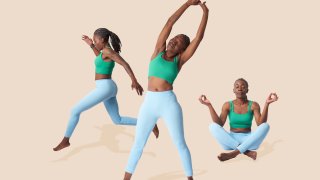
If you hate exercising, you're not alone. Even as a sports medicine doctor and physical activity advocate, I understand why living a more active lifestyle can be challenging, especially with our hectic schedules.
But prioritizing daily movement is one of the best things you can do to improve your health and quality of life. Regular exercise can help prevent medical conditions including heart disease, Type 2 diabetes, anxiety and depression, and many types of cancer.
On days when I don't feel like exercising, I practice a simple and time-efficient method to be more active without committing to a full-on workout: I add "fitness snacks" into my day.
What are 'fitness snacks'?
Get Tri-state area news and weather forecasts to your inbox. Sign up for NBC New York newsletters.
When I say fitness snacks, I don't mean pre-workout shakes or protein bars.
Fitness snacks are short bursts of activity spread out throughout the day as opposed to one long workout session. For example, instead of a 30-minute workout, you can opt for multiple 5- or 10-minute movement breaks throughout the day.
One of the easiest ways to sneak in a fitness snack is by walking. When I don't have time to commit to a full workout, I'll take a 10-minute neighborhood stroll or do a few laps around my home or office.
Money Report
It sounds simple, but most people never actually take the time to do it. And yet it's so easy! Adding it to your calendar can help as a motivation and reminder. If I end up having to skip it, I'll make up for it by taking the stairs instead of the elevator that day, or park my car furthest away from the grocery store entrance.
For years, 10,000 steps has been the standard recommended daily step count, but a 2020 study found that you can receive the same health benefits by reaching 7,000 steps a day.
On average, most of us can comfortably walk 1,000 steps in 10 minutes. This is probably faster than you would walk through the grocery store, but slower than if you were intentionally walking fast because you're late.
I meet a lot of people who have no idea how active they are. So a good starting point is to download a free step count app or get a wearable tracker. Find out where you are now in terms of how many hours you're sitting a day and how much you're walking — then determine how much to increase from there.
The benefits of 'fitness snacks'
Fitness snacks, though bite-sized, still improve heart health, boost energy levels and help you mentally reset for the rest of your day.
Most importantly, they help break up prolonged sitting, which some researchers have deemed a "silent killer" due to its negative effects on the heart, weight management and blood sugar control. A 2018 study found that sitting for more than six hours a day is associated with a higher risk of early death.
At the end of the day, any activity — even increased walking — is better than nothing. If you hate the idea of long and sweaty workout sessions, these bite-sized increments of movement may be easier to fit into your everyday life.
How much exercise you should aim for in general
Ideally, your weekly fitness snacks should add up to the Physical Activity Guidelines for Americans: 150 to 300 minutes of moderate-intensity aerobic physical activity per week, or 75 to 150 minutes of vigorous-intensity aerobic physical activity per week.
Any "breathing harder than normal" activity counts as a moderate-intensity activity, including chores and yard work like sweeping floors and raking leaves, according to the guidelines.
Here are a few things you can do in short increments:
- Walking
- Bicycling
- Jumping rope
- Climbing stairs in your home
- Bodyweight exercises (e.g., push-ups, planks, squats)
- Yoga
- Tai Chi
- Dancing
A gradual ramping of activity time and intensity will help decrease injury risk, so when incorporating a new fitness snack into your routine, start slow and start with small time increments.
Also, consider that incorporating multiple forms of activity — aerobic, strength and flexibility exercises — into your fitness routine can prevent overuse injuries and provide the widest array of benefits.
Dr. Cindy Lin, MD, is the Associate Director of Clinical Innovation for The Sports Institute at the University of Washington Medical Center and an Associate Professor in Sports and Spine Medicine in the Department of Rehabilitation Medicine. Dr. Lin earned her MD from Harvard Medical School, and her research includes musculoskeletal injuries and sports injury prevention. She has written for HealthDay and UW Medicine, among several other health and medical publications.
Don't miss:
- A Harvard-trained sports medicine doctor shares the ‘super easy’ stretch she does every day to relieve lower back pain
- To ‘stay healthy and strong,’ a dietician eats these 5 staple foods of the Mediterranean diet
- A longevity expert shares the diet, exercise and sleep rules he lives by for a longer, stronger life: These are ‘non-negotiable’
Sign up now: Get smarter about your money and career with our weekly newsletter






